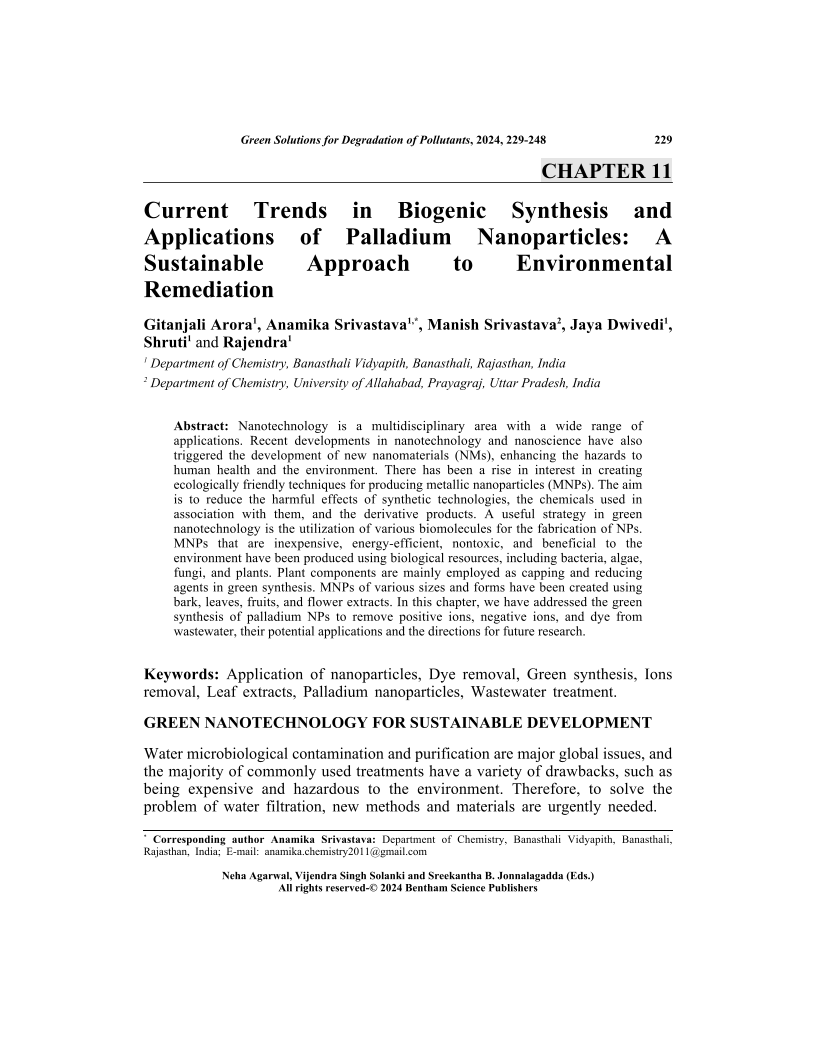Current Trends in Biogenic Synthesis and Applications of Palladium Nanoparticles: A Sustainable Approach to Environmental Remediation

- Authors: Gitanjali Arora1, Anamika Srivastava2, Manish Srivastava3, Jaya Dwivedi4, Shruti5, Rajendra6
-
View Affiliations Hide AffiliationsAffiliations: 1 Department of Chemistry, Banasthali Vidyapith, Banasthali, Rajasthan, India 2 Department of Chemistry, Banasthali Vidyapith, Banasthali, Rajasthan, India 3 Department of Chemistry, University of Allahabad, Prayagraj, Uttar Pradesh, India 4 Department of Chemistry, Banasthali Vidyapith, Banasthali, Rajasthan, India 5 Department of Chemistry, Banasthali Vidyapith, Banasthali, Rajasthan, India 6 Department of Chemistry, Banasthali Vidyapith, Banasthali, Rajasthan, India
- Source: Green Solutions for Degradation of Pollutants , pp 229-248
- Publication Date: August 2024
- Language: English
Current Trends in Biogenic Synthesis and Applications of Palladium Nanoparticles: A Sustainable Approach to Environmental Remediation, Page 1 of 1
< Previous page | Next page > /docserver/preview/fulltext/9789815238969/chapter-11-1.gif
Nanotechnology is a multidisciplinary area with a wide range of applications. Recent developments in nanotechnology and nanoscience have also triggered the development of new nanomaterials (NMs), enhancing the hazards to human health and the environment. There has been a rise in interest in creating ecologically friendly techniques for producing metallic nanoparticles (MNPs). The aim is to reduce the harmful effects of synthetic technologies, the chemicals used in association with them, and the derivative products. A useful strategy in green nanotechnology is the utilization of various biomolecules for the fabrication of NPs. MNPs that are inexpensive, energy-efficient, nontoxic, and beneficial to the environment have been produced using biological resources, including bacteria, algae, fungi, and plants. Plant components are mainly employed as capping and reducing agents in green synthesis. MNPs of various sizes and forms have been created using bark, leaves, fruits, and flower extracts. In this chapter, we have addressed the green synthesis of palladium NPs to remove positive ions, negative ions, and dye from wastewater, their potential applications and the directions for future research.
-
From This Site
/content/books/9789815238969.chapter-11dcterms_subject,pub_keyword-contentType:Journal105

